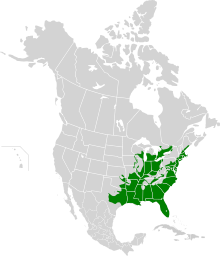Common musk turtle
| Common musk turtle | ||||||||||||
|---|---|---|---|---|---|---|---|---|---|---|---|---|

Sternotherus odoratus - hatchling |
||||||||||||
| Systematics | ||||||||||||
|
||||||||||||
| Scientific name | ||||||||||||
| Sternotherus odoratus | ||||||||||||
| ( Latreille , 1802) |
The common musk turtle ( Sternotherus odoratus ) is a small freshwater turtle species.
Appearance
The carapace of the adult animals is dark brown through dark gray to black and has no markings. It is evenly arched, narrow and elongated. A dark pattern of spots can be seen in young animals. Young animals also have three characteristic keels that disappear with increasing age.
The plastron is small and cross-shaped (bikini armor) whereby the color can vary from light beige to completely black. In this type, the seams made of connective tissue are particularly emphasized.
The head, legs and other soft tissues are colored light gray to black, although the color changes in the course of life. Depending on the specimen, two yellow stripes, one above and one below the eye from the tip of the nose to the neck (sometimes with a connection behind the eye), run along the sides of the head. These streaks can fade or disappear completely with age. There is a pair of barbels on the chin, sometimes there may be a second pair.
The common musk turtle can reach a size of 13.7 cm, but mostly only 7.5-10 cm, whereby both sexes are about the same size.
distribution
The species is distributed over a large area of eastern North America. In the north, the area borders on southern Canada . In addition, it is native to the entire US east coast to Florida . In the west, the species penetrates to Wisconsin and central Texas .
Natural habitat
All sorts of fresh water bodies are populated, such as lakes, ponds, rivers, swamp bodies and canals, with preference given to slowly flowing bodies of water with a sandy bottom. The species prefers to stay in shallow water areas. Despite the undemanding nature of the waters, brackish water is not tolerated.
Way of life
The common musk turtle is a highly aquatic species that rarely leaves the water for a few sunbaths. Fallen trees or branches are used as a place in the sun (the turtle has excellent climbing skills). Winter rigor is carried out in almost the entire range , only in the extreme south does the species remain active in winter. The species is crepuscular. In nature, the species feeds primarily on snails, aquatic insects, amphibians and also carrion. Vegetables are also taken in to a small extent.
Keeping in the aquaterrarium
The common musk turtle is an easy-to-keep species that can manage with a tank of less than 200 liters even in adulthood. As with all turtles, a well-structured tank with hiding places should be ensured. Contrary to what is often found in the literature, musk turtles are very good swimmers. After a period of acclimatization, they can cope with a higher water level; However, there should always be opportunities for ascent so that the water surface can also be reached by climbing. The diet consists mainly of animal components, with some specimens also using plant-based food. Snails, clams, fish, mosquito larvae and various insects are preferred.
Keeping outdoors
The common musk turtle can be looked after in the garden pond at home from May to October. This should have a flat bank and be sunny, as this species especially likes to sunbathe. The water level should not be much higher than 25 cm. The enclosure has to be relatively high because the common musk turtle can climb very well, glass panes, concrete blocks and palisades can be used for this.
Reproduction
The breeding season is mainly in the period from April to May and September to October. This means that 2-4 clutches can be weaned per season . The clutches usually contain 1–5 eggs, but up to 10 eggs can also be achieved. Under natural conditions the incubation period lasts 65–86 days, but in unfavorable cases it can be up to 107 days.
Economical meaning
Similar to the eared turtles ( Trachemys and Pseudemys ) and mute turtles ( Graptemys ), the common musk turtle is reproduced in American breeding farms for the global pet market.
Specialty
The German name musk turtle (in English colloquially stinkpot ) owes the turtle to its musk glands, with whose help it can secrete a strongly smelling secretion in order to drive away predators. The use of the glands is very rare when it is kept in an aquaterrarium . B. when it is picked up. They are not used free-swimming in the aquatic terrarium.
literature
- Maik Schilde: Mud turtles - Kinosternon, Sternotherus, Claudius and Staurotype , Natur und Tier-Verlag, Münster 2001, ISBN 3-931587-59-2
- Maik Schilde: The Musk Tortoise - Sternotherus odoratus , Nature and Tier-Verlag, Münster 2007, ISBN 978-3-937285-34-4
Web links
- Keeping and breeding of the common musk turtle - Sternotherus odoratus
- Keeping and breeding of the common musk turtle - Sternotherus odoratus on www.schildkroetenteiche.de
- Like a fish in water: the turtle species lives six months without surfacing
- Sternotherus odoratus in The Reptile Database
- Sternotherus odoratus inthe IUCN 2013 Red List of Threatened Species . Posted by: van Dijk, PP, 2010. Retrieved December 14, 2013.
Individual evidence
- ↑ Robert Powell, Roger Conant, Joseph T. Collins (Eds.): Peterson Field Guide to Reptiles and Amphibians of Eastern and Central North America . 4th edition. Houghton Mifflin Harcourt, 2016, ISBN 978-0-544-12997-9 (English).

